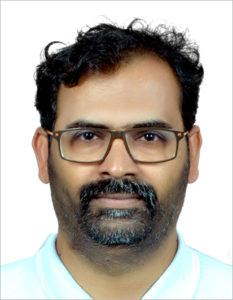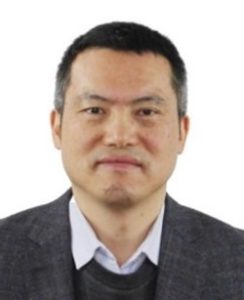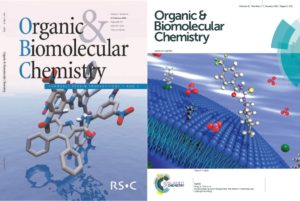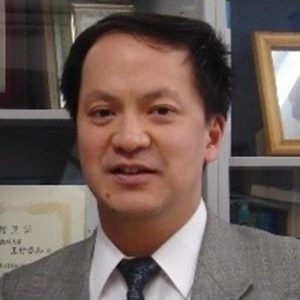2023 marks twenty years of Organic & Biomolecular Chemistry publications. As part of the celebrations, OBC has invited some of the most prominent authors across our history to give their thoughts on the last twenty years of their career alongside their predictions for the next two decades.
Our next entry to the series comes from Professor Dhevalapally B. Ramachary at the University of Hyderabad who first published with OBC in 2006 and has continued to support the journal with 27 articles across the years, most recently in 2022.
About Ramachary
 Prof. Ramachary graduated with a MSc degree in Chemistry from the University of Hyderabad and obtained a PhD in synthetic organic chemistry from the Indian Institute of Science, Bangalore in 2001. He subsequently held a postdoctoral position at the Scripps Research Institute for Catalysis, prior to joining the University of Hyderabad in January 2005, where presently he is a full professor of organic chemistry.
Prof. Ramachary graduated with a MSc degree in Chemistry from the University of Hyderabad and obtained a PhD in synthetic organic chemistry from the Indian Institute of Science, Bangalore in 2001. He subsequently held a postdoctoral position at the Scripps Research Institute for Catalysis, prior to joining the University of Hyderabad in January 2005, where presently he is a full professor of organic chemistry.
He has been the recipient of many awards including Fellow of the National Academy of Sciences (Allahabad, 2021), Fellow of the Royal Society of Chemistry (London, 2020) and Fellow of Indian Academy of Sciences (Bangalore, 2018). He has guided 20 PhD students, 13 PDFs and out of them, 5 got Eli Lilly & Company Asia Outstanding Thesis Awards. He is an Editorial Advisory Board Member for Organic & Biomolecular Chemistry (2013-present), European Journal of Organic Chemistry (2017-present) and Tetrahedron Chem (2021-present). He serves as a reviewer for many national and international reputed journals and is a member of many national funding committees (DST, SERB). Prof. Ramachary has published more than 113 research papers, 2 books on emerging organocatalysis areas, delivered over 130 lectures in national/international conferences and has a few chemical reactions named after him.
First OBC paper: D. B. Ramachary, M. Kishor & G. B. Reddy, Development of drug intermediates by using direct organocatalytic multi-component reactions, Org. Biomol. Chem., 2006, 4, 1641-1646, DOI: 10.1039/b602696f
Most recent OBC paper: A. V. Krishna & D. B. Ramachary, The seven-step, one-pot regioselective synthesis of biologically important 3-aryllawsones: scope and applications, Org. Biomol. Chem., 2022, 20, 3948-3954, DOI: 10.1039/d2ob00438k
Favourite OBC paper: D. B. Ramachary, M. Shiva Prasad, S. Vijaya Laxmi & R. Madhavachary, Asymmetric synthesis of drug-like spiro[chroman-3,3′-indolin]-2′-ones through aminal-catalysis, Org. Biomol. Chem., 2014, 12, 574-580, DOI: 10.1039/c3ob42100g
How has your research developed over the last 20 years?
I am incredibly pleased to share some of my thoughts on how our research began in 2005 upon joining the School of Chemistry, University of Hyderabad as faculty after my post-doctoral studies at The Scripps Research Institute. With the knowledge gained on total synthesis from my PhD days, followed by having exposure to developing reactions in newly thriving molecular catalysis during my post-doctoral research, I decided to commence my early investigation on the area of organocatalysis, which derived inspiration from the reactions performed in biological systems designed by nature and that are occurring sequentially in a consistent medium.
We, therefore, envisioned developing new organocatalytic domino cascade sequential one-pot multi-component and multi-catalytic cascade reactions. With this objective, several questions arose about how to mimic the biological systems in already existing reactions that use harsh conditions, metals, tedious workups and column purifications with the accompanying functional group intolerance in most cases. To address these challenges, we had to develop the reactions that maintain lenity with conditions useful in sequential one-pot methods by forming bonds in a greener manner by using solvents, catalysts and conditions that ensure that the conditions employed in the first reaction are affable to the following sequence of reactions. With this rationale, we were able to develop a new method for the alkylation of cyclic-1,3-diketones, a reaction not feasible with existing conditions. The soft nucleophilic centre present in cyclic-1,3-diketones when treated with a soft electrophile like methyl iodide, allyl bromide, benzyl bromide and propargyl bromide resulted in a maximum 70% yield of the desired C-alkylation product. However, when using a hard electrophile, it resulted in only O-alkylated products. With our systematic efforts, we developed a three-component reductive alkylation of CH-acids with aldehydes/ketones in the presence of an amine or amino acid catalyst by using Hantzsch ester as a reducing agent. This is a preliminary reaction to the designed sequential one-pot combination of MCRs/MCC reactions. This method has become a beneficial tool in creating various highly functionalized biologically active molecules with wide pharmaceutical applications. This diversity-orientated green one-pot synthetic strategy has received much acclaim and is recognised as the “Ramachary Reductive Coupling Reaction”.
We later added a new dimension to our research by developing push-pull dienamine catalysis to synthesise complex organic molecules. We developed a novel regioselective, one-step, cascade Claisen-Schmidt/ iso-aromatisation reaction that could furnish highly functionalized phenols in a regio-specific manner using a simple aldehyde possessing a non-enolizable carbonyl functional group with highly substituted Hagemann’s esters under diamine catalysis. It is the first example of its kind in literature where push-pull dienamines have been generated in situ and it has stood out as an excellent platform for cascade reactions.
The discovery of copper-catalysed [3+2]-cycloaddition (the 2022 Chemistry Noble Prize-Winning Reaction) for the selective synthesis of 1,2,3-triazoles evoked interest among the synthetic community due to the significance of functionalized 1,2,3-triazoles and studies of their properties being widespread. Even though the copper-catalysed click reaction has broad utility, it has some drawbacks. To address the drawbacks imminent with existing click reactions, we have developed a common metal-free, green enamine- or enolate-mediated organocatalytic click reaction for the synthesis of 1,4-disubstituted, 1,5-disubstituted and 1,4,5-trisubstituted 1,2,3-triazoles in a more sustainable manner. Unlike the copper catalyst for [3+2]-cycloaddition of different terminal alkynes with azides, we have used relatively greener conditions by using organocatalyst like proline/DBU and were able to demonstrate the [3+2]-cycloaddition between alpha-methylene carbonyl compounds (because of their wide availability, stability and acidity) as the dipolarophile source and the aryl/alkyl-azides to synthesise the substituted 1,2,3-triazoles.
In 2012, we developed an asymmetric synthesis for drug-like spiranes through reflexive-Michael reaction using 2-aminobuta-1,3-enyne catalysis under mild conditions. Functionalized spirooxindoles were furnished in good yields with excellent stereoselectivities by using an effective Tomita zipper cyclisation reaction through organophosphine catalysis on the ynones and active olefins. Later we developed asymmetric supramolecular-organocatalysis; a bio-inspired tool for high asymmetric induction where two catalysts were used synergistically to induce high enantioselectivity for constructing enantiomerically pure drug-like hexahydroxanthenes and spriodihydrocoumarins with three contiguous stereocenters from simple precursors under mild conditions. This vital tool demonstrates the synthesis of various compounds showing potent biological activities. It has become significant in understanding the pre-transition state theory in organic chemistry. The in situ generated chiral supramolecular assembly catalysts could become great future catalytic systems for more functionalized substrates.
Our group is continuously striving to develop new catalytic reactions that can become valuable tools to make organic reactions greener and sustainable while demonstrating the synthesis of more drugs and natural products in a sequential one-pot manner.
How has the field of organocatalysis changed over the last 2 decades?
Over the last two decades, there has been an exponential proliferation of organocatalysis in every domain of chemistry, which is evident from the ~1500 articles per year. The role of organocatalysis in the synthesis of chiral organic compounds makes it a fundamental tool in catalytic asymmetric organic synthesis, which has several advantages over metal-catalysed and enzyme-catalysed reactions like the use of elementary organic molecules such as amino acids, the use of extraordinarily mild conditions with operational simplicity, functional group tolerance and broad applicability. The contributions from Professors Carlos F. Barbas III, David W. C. MacMillan and Benjamin List in the late 2000s laid the way for a paradigm shift in expanding the area from making simple asymmetric C-C bonds to a much wider scope of bond formations (C-O, C-N, C-X, C-S, C-P, C-H) and an eventual Chemistry Nobel Prize for the area in 2021.
In organic chemistry, achieving excellent diastereo- / enantio-selectivity and construction of pure single enantiomers is not easy, except for a few reactions like the Sharpless epoxidation, Noyori hydrogenation etc. Organocatalysis is solving challenging stereoselective transformations in vital areas which include aminocatalysis, Brønsted-acid catalysis, H-bonding catalysis, N-heterocyclic carbene catalysis, ion-pairing catalysis, oligopeptide (foldamers) catalysis, SOMO-catalysis, organosuperbases/frustrated Lewis pairs promoted catalysis, bifunctional catalysis and synergistic catalysis to name a few. Numerous valuable challenging chemical asymmetric transformations are unveiled with this tool making chemical industries chiral, greener and more sustainable.
Much more is yet to be discovered with this beautiful asymmetric platform. Unifying this platform with other fields like photoredox catalysis, electrochemistry, nanochemistry, flow chemistry and solid phase synthesis will undoubtedly be revolutionary in chiral drug discovery, natural product synthesis and material chemistry. The shortcoming of organocatalysis is that it is less efficient that metal or enzyme catalysis at low parts-per-million (ppm) level catalyst loadings. Moreover, the organocatalysts are usually required in higher quantities (up to 30 mol%). Asymmetric organocatalysed reactions with extremely low catalyst loadings are one step higher in their evolution. They are the need of the hour as they would be highly appreciable in pharmaceutical industries. General challenges associated with developing low ppm-level organocatalysed reactions include the requirement of very high reaction rates, preventing catalyst poisoning from impurities/by-products, rapidity of catalyst regeneration, catalyst stability and product stability under the reaction conditions.
Where do you see the challenges being for this field over the next 20 years?
Although we can reaffirm that organocatalysis has become an efficient tool capable of replacing metal and enzyme catalysis, we cannot completely rule out some of its drawbacks. The most important feature of this catalysis is that it has cleverly solved most typical problems which were once thought impossible. Nevertheless, this rapidly developing catalysis has suffered disadvantages like high catalyst loading and less efficiency than the highly explored metal or enzyme catalysis at ppm level loading. Furthermore, in comparison to intricate transition metal complexes, the simple organic molecules as catalysts were thought to once be incapable of performing all types of reactions. The deliberation in employing organocatalysis is evident in several areas but it cannot achieve excellent enantioselectivities with some of the highly functionalised substrates.
Therefore, it becomes necessary for synthetic chemists to design catalytic systems and conditions in such a way that they are useful with a wide variety of substrates. Thus, the design of functionally rich catalysts is essential, and it may only be possible with in situ combining some of the known catalysts because of cost effectiveness. However, this drawback is addressed by developing reactions employing an in situ supramolecular organocatalysis approach where more than two or three catalysts are employed in the reaction and act synergistically to produce high enantioselectivities than their single catalytic counterparts. In order to develop such types of technologies, a detailed understanding of the pre-transition states, reaction mechanisms and reactivity’s of the molecules, just like the molecular designing at the cellular level becomes highly essential.
One more challenge is recycling and reusing the employed organocatalyst, especially in the case of very costly catalysts, which stands as a severe issue that needs attention. The problem of high catalytic loading comes only with costly catalysts. Therefore, wisely switching PPM and PPB level catalyst loading to achieve good turnover numbers is the need of the hour to make organocatalysis thrive ahead in the evolution of greener and more sustainable reactions.
Another challenge and advantage of organocatalysis is the ability to not require protection and de-protection of functional groups when designing sequential one-pot strategies which increases the applicability of this tool, mainly at the industrial scale-up level. Organocatalysts often employ dilute solutions, which makes the reaction industrially less feasible. Alternatively, flow/solid support systems can find an advantage in solving this problem of catalyst loading and dilution problems. Though this catalytic approach can solve many problems, there is much room still left for further exploration in solving the fascinating mysteries of organocatalysis.
Check out the other entries in our blog series here!




















